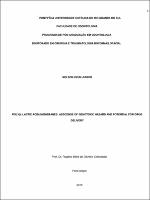| Share record |


|
Please use this identifier to cite or link to this item:
https://tede2.pucrs.br/tede2/handle/tede/7156Full metadata record
| DC Field | Value | Language |
|---|---|---|
| dc.creator | Uzun Junior, Nelson | - |
| dc.creator.Lattes | http://buscatextual.cnpq.br/buscatextual/visualizacv.do?id=K4221843U1 | por |
| dc.contributor.advisor1 | Oliveira, Rogério Belle de | - |
| dc.contributor.advisor1Lattes | http://buscatextual.cnpq.br/buscatextual/visualizacv.do?id=K4708433D6 | por |
| dc.date.accessioned | 2017-03-13T16:56:33Z | - |
| dc.date.issued | 2015-06-25 | - |
| dc.identifier.uri | http://tede2.pucrs.br/tede2/handle/tede/7156 | - |
| dc.description.resumo | Define-se biomaterial como qualquer substância proveniente de fontes naturais ou sintéticas, que possam ser utilizados nos tecidos biológicos sem provocar reações deletérias ao sistema. Amplamente utilizado a mais de quatro décadas, o titânio tem um papel importante nas diversas áreas da saúde. Ainda assim seu uso não pode ser considerado completamente seguro. A literatura relata a presença de atrofia ou deformação óssea quando este material é utilizado para o tratamento de fraturas ou reabilitações em pacientes jovens, além de interferir em alguns exames de imagem e apresentar desconforto ao toque. Os polímeros absorvíveis, em particular o PLA, são materiais com a vantagem de ser completamente absorvidos pelo organismo. Embora o uso do PLA como material para síntese óssea seja conhecido, pesquisas com a finalidade de compreender melhor o comportamento deste polímero frente aos tecido biológicos são necessárias, pois ele apresenta características físicas e químicas diferentes do titânio, de forma que pode oferecer vantagens em relação ao metal. Estes estudos in vitro avaliaram o comportamento do titânio e do PLA em nível celular e molecular. Nenhum efeito citotóxico ou genotóxico foi observado nos ensaios realizados com as células 3T3 e CHO-K1. Além disso a replicação e a expressão gênica se mantiveram inalteradas tanto nos experimentos realizados com o titânio como com o PLA. Este último ainda mostrou a capacidade de incorporar e liberar moléculas. | por |
| dc.description.abstract | Biomaterial is defined as any substance from natural sources or synthetic, that can be used in biological tissues without causing deleterious reactions to the body. Widely used for more than four decades, the titanium has an important role in various areas of health. Its use cannot be considered completely safe. The literature reports the presence of atrophy or bone deformation when this material is used for the treatment of fractures or rehabilitation in young patients, in addition to interfering in some imaging tests and uncomfortable to touch. The absorbable polymers, in particular the PLA, are materials with the advantage of being completely absorbed by the body. Although the use of PLA as material for bone synthesis is known, research with the purpose of better understanding the behavior of this polymer front to biological tissue are necessary, because it has different physical and chemical characteristics of titanium, so that you can offer advantages in relation to the metal. These in vitro studies evaluated the behavior of titanium and the PLA at the cellular level and molecular. No cytotoxic effect or genotoxic was observed in the tests with the cells 3T3 and CHO-K1. In addition to replication and gene expression remained unchanged in both experiments with titanium as with the PLA. The latter also showed the ability to incorporate and release molecules. | eng |
| dc.description.provenance | Submitted by Setor de Tratamento da Informação - BC/PUCRS ([email protected]) on 2017-03-13T16:56:33Z No. of bitstreams: 1 TES_NELSON_UZUN_JUNIOR_PARCIAL.pdf: 860913 bytes, checksum: 8b7a423424bb4dfd9536bbf025f546c9 (MD5) | eng |
| dc.description.provenance | Made available in DSpace on 2017-03-13T16:56:33Z (GMT). No. of bitstreams: 1 TES_NELSON_UZUN_JUNIOR_PARCIAL.pdf: 860913 bytes, checksum: 8b7a423424bb4dfd9536bbf025f546c9 (MD5) Previous issue date: 2015-06-25 | eng |
| dc.format | application/pdf | * |
| dc.thumbnail.url | http://tede2.pucrs.br:80/tede2/retrieve/167425/TES_NELSON_UZUN_JUNIOR_PARCIAL.pdf.jpg | * |
| dc.language | por | por |
| dc.publisher | Pontifícia Universidade Católica do Rio Grande do Sul | por |
| dc.publisher.department | Faculdade de Odontologia | por |
| dc.publisher.country | Brasil | por |
| dc.publisher.initials | PUCRS | por |
| dc.publisher.program | Programa de Pós-Graduação em Odontologia | por |
| dc.rights | Acesso Aberto | por |
| dc.subject | MATERIAIS DENTÁRIOS | por |
| dc.subject | TRAUMATOLOGIA BUCOMAXILOFACIAL | por |
| dc.subject | ODONTOLOGIA | por |
| dc.subject.cnpq | CIENCIAS DA SAUDE::ODONTOLOGIA | por |
| dc.title | Poly(L-lactic acid) membranes : abscense of genotoxic hazard and potential for drug delivery | por |
| dc.type | Tese | por |
| Appears in Collections: | Programa de Pós-Graduação em Odontologia | |
Files in This Item:
| File | Description | Size | Format | |
|---|---|---|---|---|
| TES_NELSON_UZUN_JUNIOR_PARCIAL.pdf | Texto Parcial | 840.74 kB | Adobe PDF |  Download/Open Preview |
Items in DSpace are protected by copyright, with all rights reserved, unless otherwise indicated.




